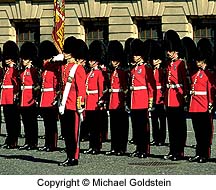
…They’re changing the guard at Buckingham Palace, Christopher Robin went down with Alice….” Today, thousands of us, perhaps including Alice, Christopher Robin, and even A.A. Milne himself, are here. We are all here together, in front of Buckingham Palace, waiting for one of the best-known tourist spectacles in the Western world.
Standing in a light rain, under umbrellas, newspapers, anoraks or wet hair, we take up every available square inch of room. Some of us have been here for an hour. There is an anticipatory air of excitement, as we await the first blare of brass horn, boom of drum, or glimpse of bearskin hat. We have all brought our cameras.
My location, directly in front of the Palace, has been carefully chosen to observe the parade as it arrives from Birdcage Walk, passing in front of me. If I swing sharply to the left, I will be eye to eye with the retiring guard, as it leaves for Wellington Barracks. I dare say that, to see the entire ceremony and parade, you must come at least four times, taking a different position each time.
A fanfare of music, excitement among the mounted police, then a blaze of crimson uniforms, and here they come. It is amazing how much impact this event has, even after watching it many times on film or television. On these wet days, those red uniforms jump out of the background like fresh roses. All that brass takes on a wonderful glow, and the yellow slickers worn by my fellow tourists are positively fluorescent. No need for fill light here, just a fast film to beat the low light level into submission.
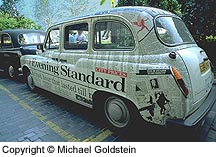
They are very wary about tripod-mounted cameras with telephoto lenses attached, anywhere in the vicinity of the Palace. However, monopods seem not to intimidate anyone. A side benefit is that you can deal with close-pressing crowds much more easily, and retain your good humour.
Navigating London is easy. I have a tourist guide book, and a compass. The London “underground” system has been explained to me, with its different colour-coded lines, its multiple interchange stations, and the “journey planner” guide sheets handed out free at every station. I was wise enough (warned, to be more honest) to buy a three-day pass for the transit system before I left North America. (There is an “all day” ticket that lets you travel anywhere on the system for a two pound investment.) Carry your tripod on a sling over your shoulder, and your camera gear in a backpack … you’ll be climbing a lot of steep stairs!
Leaving the area of Buckingham Palace, I cross over to St. James Park, and walk through it, paralleling the Mall. Discovering crimson uniforms guarding the gates of St. James Palace, I tarry a while. The god of photographers looks down, I hear the tramp of boots along the street, and a change of guard arrives while I am standing there, looking on. No brass bands, but much clashing of heels on pavement, and shouting of commands.
Everyone should walk down the Mall once, imagining they are in a coach pulled by white horses, passing through Royalty’s special gate, at Admiralty Arch. Nelson’s Column soars above Trafalgar Square at this point, a majestic memorial. I decide not to walk up Charing Cross Road to see if the nightingales still sing in Leicester Square, but opt instead for lunch.
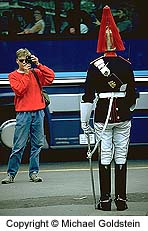 From Trafalgar Square, it is a short walk down Whitehall to the Horse Palace, and the Horse Guards Parade. The Life Guards, mounted on their chargers, are a big attraction. Tourists love to be photographed beside them, and arrive in droves whenever the Guards appear.
From Trafalgar Square, it is a short walk down Whitehall to the Horse Palace, and the Horse Guards Parade. The Life Guards, mounted on their chargers, are a big attraction. Tourists love to be photographed beside them, and arrive in droves whenever the Guards appear.
It’s almost as much fun photographing the antics of the tourists, as the Guards themselves. To see over the heads of the crowds in front of me, I place my wide-angle lens on my monopod, and attach a long shutter-release cable. I set the lens for hyperfocal-distance focus, raise the monopod over my head, and start shooting. My motor drive recocks the shutter after every exposure, and I shoot ’till my arm gets tired.
Continuing down Whitehall brings me to Downing Street, where I hope for a glimpse of the famous Number Ten – but there are barricades at the entrance to the street, and a polite ‘bobby’, who confirms I am definitely not invited to tea with the Prime Minister.
Whitehall becomes Parliament Street, and I can see Big Ben ahead of me. I’ve heard him ‘bonging’ through the day. I press on, and there he is, attached to the Houses of Parliament.
I’m now on St. Margaret Street, which shortly becomes Abingdon Street, right in front of the Parliament Buildings. One of the problems of navigating London is the charming tendency for streets to change names in mid-stream, without warning.
The scale of the Parliament Buildings is inspiring. The eye can wander for hours over the intricate detail that adorns them. This is the source of so much of the democratic theory by which a large portion of the world is governed …. a sobering thought. They make great abstract photographs.
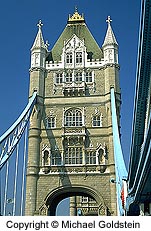 The Victoria Embankment begins on the west side of the Thames at Westminster Bridge, curves north and east, and makes an excellent walk along the river. Anyone who has ever read a spy or murder story, based in London, knows the Embankment.
The Victoria Embankment begins on the west side of the Thames at Westminster Bridge, curves north and east, and makes an excellent walk along the river. Anyone who has ever read a spy or murder story, based in London, knows the Embankment.
“… Footsteps are heard in the fog, there is a shriek, a splash, and the footsteps fade away. Next day, the Ambassador’s body is recovered at Tower Bridge…” Lovers meet there, diplomats solve the world’s problems while strolling along its length, spies exchange mysterious envelopes. … it is also a great place for visitors. On a sunny day, the Bridge makes a great location for photography.
A favourite attraction is Cleopatra’s Needle, older than London itself, and boasting a chequered history. The voyage of this monolith to London is itself a fascinating story, full of adventure and derring-do. Soaring arches, gold leaf ornamentation, circles within circles, architecture to delight the eye. St. Paul’s Cathedral is a tribute in stone to art, religion, civilization. The dome itself, visible from the main floor, is a vast distance from the floor. One daring soul lies flat upon his back to photograph it. Nobody manages to step on my head. My energy is beginning to flag, and it is time for supper. Piccadilly Circus is an area replete with Indian and Italian restaurants. You can smell the spices in the air, and I am soon enjoying a delicious cannelloni. The following morning, I am again on the Embankment. Just across from the tube station, the Thames ferry runs each half hour, starting at 10:30 in the morning. I have been instructed not to miss Greenwich, and the Royal Observatory.
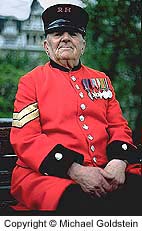 On my way to the ferry, another London attraction catches my eye. Sitting on a park bench is an ancient gentleman with a dignified and military air, in a bright red uniform jacket that bristles with medals. It is a photographic opportunity too good to pass up.
On my way to the ferry, another London attraction catches my eye. Sitting on a park bench is an ancient gentleman with a dignified and military air, in a bright red uniform jacket that bristles with medals. It is a photographic opportunity too good to pass up.
“Excuse me, sir, may I say that you look quite splendid in that uniform? I wonder if you would allow me to photograph you in it?” He turns, and bestows upon me a glare from ice blue eyes that would make the stoutest sergeant quail. I prepare myself for a parade-ground bellow that will put me firmly in my place … “Sure, sonny, but it’ll cost you fifty pence!” The blue eyes now contain a twinkle.
The only coin I have is a pound piece, so I give it to him, and he cheerfully sits for a number of photos. I even coaxe a passing tourist into holding my large reflector, so I can bounce some fill light up into his face. Later, I discover he is a “Chelsea pensioner”, a retired military man still in service to the Queen, and privileged to attract tourist pennies by posing in his uniform … and the medals are real.
Greenwich holds a number of attractions for the visitor. For the Scotch drinker and boating enthusiast, the Cutty Sark lies moored beside the ferry dock, a multi-masted square rigger of great renown. Just beyond her, the Gypsy Moth IV is tied up. Sir Francis Chichester took this small sailboat around the world, single handed. For his exploits, he was knighted by the Queen. The sword used in the ceremony was the same sword employed in bestowing a similar honour on a prior Chichester ancestor, many years ago.
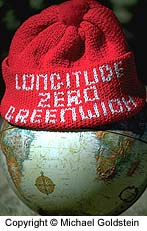 The Royal Observatory, on a hill above the town, attracts many visitors. The reference point for Greenwich Mean Time, the universal world time system, is here. I am a radio amateur, accustomed to talking with other enthusiasts around the globe, and always using GMT for logging and time-keeping purposes. For me, coming to Greenwich is a pilgrimage.
The Royal Observatory, on a hill above the town, attracts many visitors. The reference point for Greenwich Mean Time, the universal world time system, is here. I am a radio amateur, accustomed to talking with other enthusiasts around the globe, and always using GMT for logging and time-keeping purposes. For me, coming to Greenwich is a pilgrimage.
At the Observatory, you can stand astride the “Zero Meridian”, the actual calibration point that separates the Eastern and Western hemispheres. Of course, like any tourist, I set up my camera, and photograph myself doing so! I could spend several days at Greenwich, but my afternoon has passed, and there is no more time.
The criterion of any interesting place is the desire, as you leave, to return. I have just barely ‘scratched the surface’ of this historic city, and yet I have spent two of the busiest days of my life here. Checking my list, I feel I’ve done very well indeed, for the time available. Perhaps with another week, or two, or a month, or a year, I could say, “I know London!”.
by Michael Goldstein

Leave a Reply